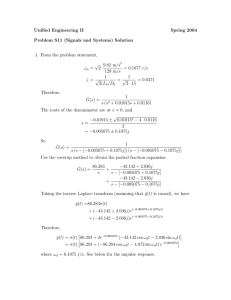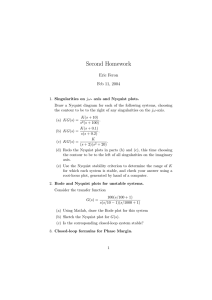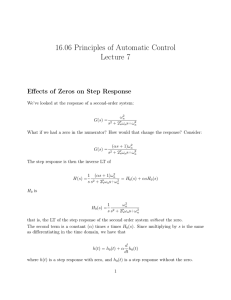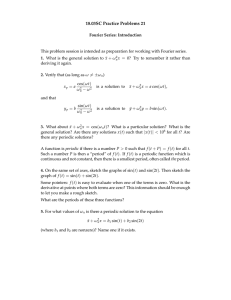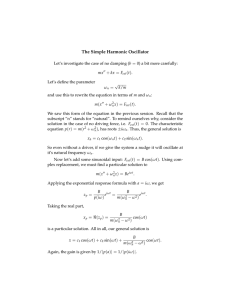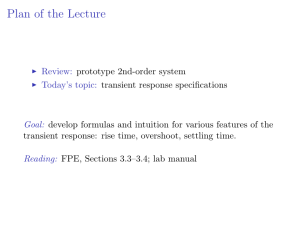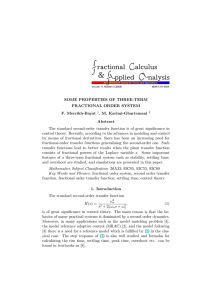15.4.3 Relative Stability: Gain and Phase Margins
advertisement
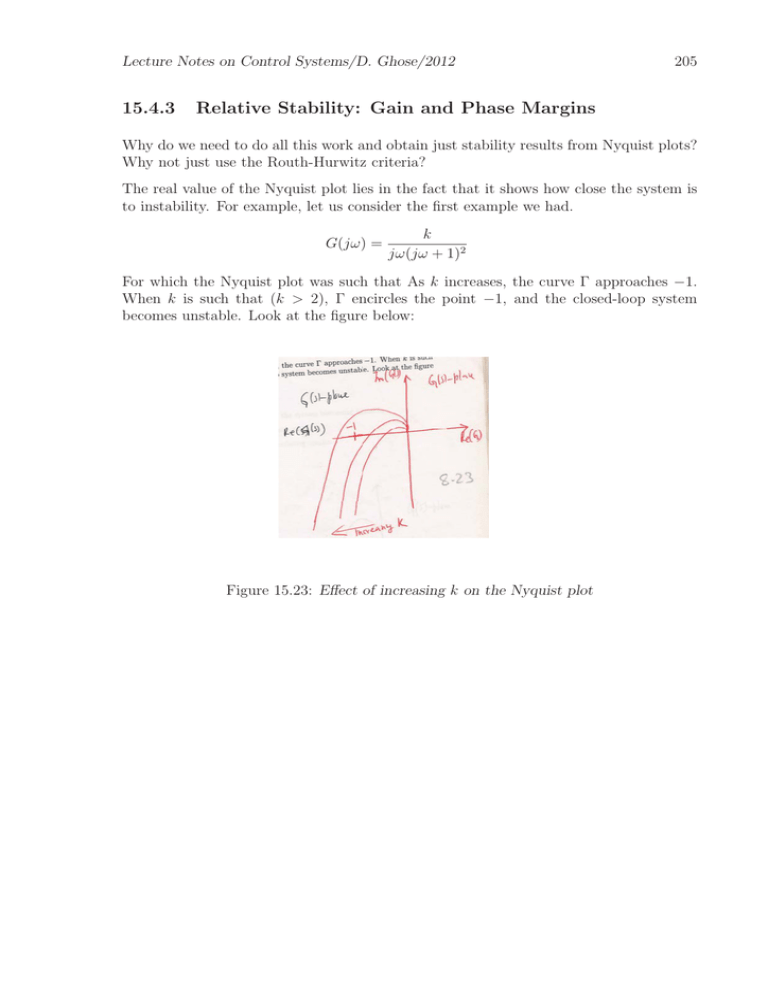
Lecture Notes on Control Systems/D. Ghose/2012 15.4.3 205 Relative Stability: Gain and Phase Margins Why do we need to do all this work and obtain just stability results from Nyquist plots? Why not just use the Routh-Hurwitz criteria? The real value of the Nyquist plot lies in the fact that it shows how close the system is to instability. For example, let us consider the first example we had. G(jω) = k jω(jω + 1)2 For which the Nyquist plot was such that As k increases, the curve Γ approaches −1. When k is such that (k > 2), Γ encircles the point −1, and the closed-loop system becomes unstable. Look at the figure below: Figure 15.23: Effect of increasing k on the Nyquist plot Lecture Notes on Control Systems/D. Ghose/2012 206 Gain Margin: The gain margin is the factor by which the gain |G(jω)| needs to be increased for the closed-loop system to be neutrally stable. The gain margin (GM) is defined as: GM = |G(jω180◦ )|−1 where, ω180◦ is such that G(jω180◦ ) = 180◦ The gain margin is normally expressed in dB. Phase Margin: Phase margin (PM) is the amount by which the phase of G(jω) exceeds 180◦ when |G(jω)| = 1. It is defined as, PM = G(jωc ) − 180◦ where, the frequency ωc is such that |G(jωc )| = 1. It is also called the phase cross-over frequency. Figure 15.24: The gain and phase margins Application to Design Assume a stable open-loop system. Then, GM > 0 (in dB) ⇒ Closed-loop system is stable. GM > 6 dB is good ⇒ You can double the gain without the system becoming unstable. PM > 30◦ is good (Note that PM =0◦ → denotes neutrally stable). For unstable open loop system, PM and GM can give confusing results. Lecture Notes on Control Systems/D. Ghose/2012 207 Figure 15.25: The gain and phase margins from Bode plot GM and PM from Bode Plot GM and PM tells you how much uncertainty one can tolerate in the open loop system before the closed loop system goes to instability. Phase margin is related to closed loop damping ratio and so to the overshoot. To show this, consider an open loop system, GoL (s) = ωn2 ωn2 = s2 + 2ζωn s s(s + 2ζωn ) which produces the closed loop system (with unity feedback and unity gain), GcL (s) = ωn2 s2 + 2ζωn s + ωn2 Getting back to the open loop system, G(jω) = −ωn2 ωn2 = 2 jω(jω + 2ζωn ) ω − j2ζωn ω 2 ωn |G(jω)| = ω 4 + 4ζ 2 ωn2 w2 Find ωc , the crossover frequency. |G(jωc )| = 1 ⇒ ωn4 = ωc4 + 4ζ 2 ωn2 ωc2 ⇒ ωc = ωn 1+ 4ζ 4 − 2ζ 2 1/2 Lecture Notes on Control Systems/D. Ghose/2012 208 Now, find the phase margin as follows, PM = tan−1 = tan−1 −Im(G(jω) −Re(G(jω)) Im(G(jω)) Re(G(jω)) ω=ωc ω=ωc Now, −ωn2 (ω 2 + j2ζωn ω) −ωn2 = G(jω) = ω 2 − j2ζωn ω ω 4 − 2ζ 2 ωn2 ω 2 So, PM = tan−1 −1 = tan 2ζωn ωc ωc2 = tan−1 2ζ √ [ 1 + 4ζ 4 − 2ζ 2 ]1/2 Plotting the PM vs. ζ, we will get, Figure 15.26: PM vs. ζ 2ζωn ωc Lecture Notes on Control Systems/D. Ghose/2012 209 So, Small PM ⇒ small ζ ⇒ large overshoot (but fast response). Large PM ⇒ large ζ small overshoot (but slow response). One can come up with design procedure in the frequency domain too. We omit the details. PROBLEM SET 9 1. Sketch the Nyquist plots for the following loop transfer functions. Find out N, P , and Z and determine if the closed loop system is stable. If yes, then for what values of K(s) = k is the system stable? (a) G(s) = 20 s(1 + 0.1s)(1 + 0.5s) (b) G(s) = 3(s + 2) + 3s + 1 s3 (c) G(s) = 100 s(s + 1)(s2 + 2) 2. Let the open loop transfer function be given by G(s) = k (s + 1)n Consider n = 2, 3, 4 and find out the range of k for which the closed loop system is stable, using Nyquist plot. 3. For all the systems above sketch the Bode plots. 4. For all the systems above determine the phase and gain margins if they are relevant. 5. Check all the results using MATLAB.
